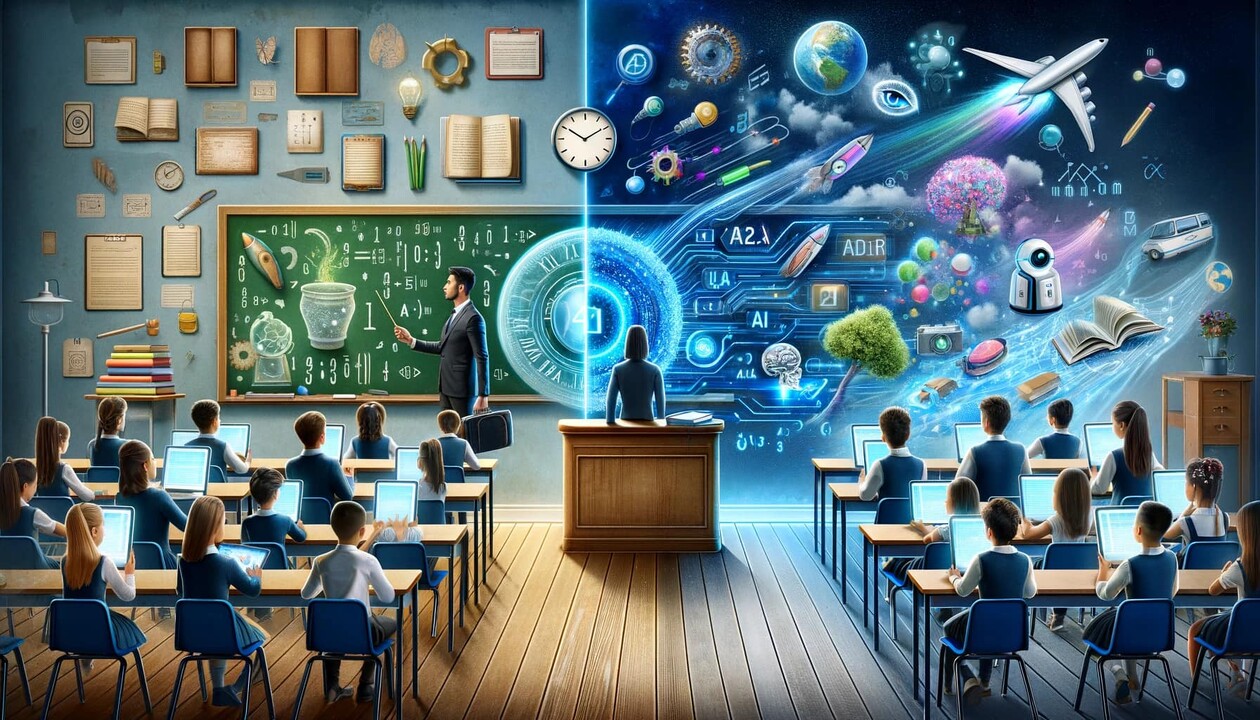Artificial Intelligence (AI) is no longer a futuristic concept limited to sci-fi movies—it is becoming a powerful force that is reshaping the very foundation of education. Classrooms across the world are being transformed through AI-powered tools, intelligent platforms, and data-driven insights. From personalized learning to automated grading, AI is helping teachers create more engaging, efficient, and inclusive learning environments.
- The Evolution of AI in Education
- Personalized Learning for Every Student
- Automating Administrative Tasks for Teachers
- Enhancing Classroom Engagement
- Real-Time Feedback and Assessment
- Bridging Language Barriers
- Supporting Special Education Needs
- Data-Driven Decision Making
- Preparing Students for the Future Workforce
- Virtual Classrooms and Remote Learning
- Addressing Challenges and Concerns
- Expert Opinions on AI in Classrooms
- FAQs
- Conclusion:
The use of AI in education is not just about introducing advanced technology; it’s about redefining how teachers teach and how students learn. A 2024 report by UNESCO revealed that global spending on AI in education is expected to surpass $20 billion by 2030, with adoption rates increasing rapidly in both developed and developing countries. This is a clear indication that AI is not a passing trend—it’s here to stay.
But how exactly is AI changing the classroom experience? What benefits does it bring, and what challenges must schools and teachers be prepared for? This article dives deep into these questions, exploring the role of AI in transforming teaching and offering a comprehensive view of its impact on modern classrooms.
The Evolution of AI in Education
To truly understand the present, we need to look at the past. Education has always evolved with technology—from the chalkboard to the overhead projector, from desktop computers to online learning platforms. Each wave of innovation made teaching more dynamic and learning more accessible.
AI, however, is different. Unlike previous technologies that were mere tools, AI acts as an intelligent partner in the teaching process. It doesn’t just display content or store information—it learns, adapts, and provides feedback in real-time. This ability to analyze and respond makes AI unique and immensely powerful in education.
Personalized Learning for Every Student
One of the biggest challenges teachers face is meeting the diverse needs of their students. No two learners are alike—some grasp concepts quickly, while others need more time and support. Traditionally, it was nearly impossible for teachers to tailor lessons to each individual.
AI is changing that. Adaptive learning systems, powered by AI, analyze students’ strengths and weaknesses in real time. Based on this data, the system adjusts the pace, style, and difficulty of lessons.
For instance, if a student struggles with algebra but excels in geometry, the AI system will assign additional practice problems in algebra while allowing the student to progress faster in geometry. This ensures that no child is left behind while also preventing advanced learners from feeling held back.
A 2023 study by McKinsey found that personalized AI-driven learning could improve student outcomes by up to 30%, especially in mathematics and science.
Automating Administrative Tasks for Teachers
Teachers often spend hours outside of classroom time grading assignments, preparing lesson plans, and handling paperwork. According to the National Center for Education Statistics, teachers in the U.S. spend nearly 7 hours per week on grading alone.
AI offers a solution. With automated grading tools, multiple-choice tests, quizzes, and even short written assignments can be graded instantly. More advanced AI tools can assess student essays for grammar, structure, and clarity, providing detailed feedback within seconds.
This automation doesn’t just save time—it allows teachers to focus more on interactive teaching, mentoring, and building strong relationships with their students.
Enhancing Classroom Engagement
Keeping students engaged in today’s digital age is harder than ever. Traditional lectures often struggle to hold the attention of students accustomed to interactive content on smartphones and tablets.
AI-powered teaching assistants and chatbots are stepping in to make learning more interactive. These virtual assistants can answer student questions at any time, provide extra explanations, and even recommend additional resources tailored to their needs.
Gamification is another area where AI shines. By incorporating game-like elements such as badges, challenges, and leaderboards into lessons, AI-driven platforms make learning feel more like play. Studies show that gamified learning can boost student engagement by nearly 60%.
Real-Time Feedback and Assessment
In traditional classrooms, students often have to wait days or even weeks to receive feedback on their assignments. This delay can slow learning progress.
AI tools provide instant feedback. Whether it’s correcting a math equation, flagging a grammatical error, or pointing out logical flaws in an essay, AI ensures students know exactly where they went wrong and how to improve.
Teachers also benefit from this immediate feedback. They can quickly identify patterns, such as common mistakes across a class, and adjust their teaching methods accordingly.
Bridging Language Barriers
Language differences can be a major obstacle in classrooms, especially in multicultural societies. AI-powered translation tools are breaking down these barriers by offering real-time translation of lectures, lessons, and assignments.
For example, a student whose first language is Spanish can now receive instant translations of lessons taught in English. Similarly, AI-powered speech recognition tools can help students practice pronunciation and improve fluency.
This is particularly beneficial in global classrooms where students from different countries and backgrounds come together for online learning.
Supporting Special Education Needs
AI is proving to be a game-changer for students with learning disabilities. Intelligent tools are being developed to support children with dyslexia, ADHD, autism, and other learning challenges.
For example, AI text-to-speech software helps dyslexic students by reading aloud written content. Predictive typing tools assist students with writing difficulties by suggesting words and correcting spelling in real time.
Teachers can also use AI to track progress more effectively, ensuring students with special needs receive the personalized attention they require.
Data-Driven Decision Making
Classrooms generate massive amounts of data—from attendance records to test scores, participation levels, and behavior reports. For teachers, making sense of this data can be overwhelming.
AI turns raw data into actionable insights. By analyzing trends and patterns, AI can help teachers identify at-risk students, predict future performance, and recommend targeted interventions.
School administrators can also use AI analytics to make informed decisions about curriculum design, resource allocation, and teacher training.
Preparing Students for the Future Workforce
The future job market will be dominated by AI, automation, and digital technologies. According to the World Economic Forum, 85 million jobs will be displaced by automation by 2025, but 97 million new roles will emerge that require advanced technological skills.
By introducing AI into classrooms today, schools are preparing students for the workplace of tomorrow. From coding and data analysis to AI ethics and digital literacy, students are gaining skills that will be essential in the years ahead.
Virtual Classrooms and Remote Learning
The COVID-19 pandemic accelerated the adoption of remote learning, and AI played a critical role in making it effective. Intelligent learning platforms enabled teachers to monitor student engagement, track progress, and even detect signs of academic dishonesty during online exams.
AI-driven virtual tutors are now available 24/7, ensuring that learning continues beyond the walls of the classroom. This flexibility has made education more accessible to students in rural areas, conflict zones, and underserved communities.
Addressing Challenges and Concerns
While AI has immense potential, it also comes with challenges.
Equity and Access: Not all schools have the resources to adopt AI tools, potentially widening the gap between wealthy and underprivileged students.
Data Privacy: With AI collecting vast amounts of student data, concerns about privacy and security are growing.
Teacher Roles: Some fear that AI might replace teachers. However, experts argue that AI should be seen as an assistant, not a replacement. Human empathy, creativity, and mentorship remain irreplaceable.
Expert Opinions on AI in Classrooms
Education experts stress that AI must be integrated thoughtfully. Dr. Karen Harris, a professor of education technology, notes, “AI should be used to empower teachers, not replace them. The human element in education—empathy, moral guidance, and social connection—cannot be replicated by machines.”
Similarly, UNESCO has emphasized the importance of ethical frameworks to ensure AI in education is inclusive, equitable, and transparent.
FAQs
Will AI replace teachers in the future?
No, AI is designed to assist teachers by automating tasks and providing insights. Human qualities like empathy, creativity, and mentorship cannot be replaced by machines.
How does AI help students with learning difficulties?
AI tools such as text-to-speech, predictive typing, and adaptive learning platforms provide personalized support for students with disabilities, making learning more inclusive.
Is AI in education only for developed countries?
Not at all. Many developing countries are also adopting AI tools, especially in online learning, language translation, and mobile-based education platforms.
What are the risks of AI in classrooms?
The main risks include unequal access to technology, data privacy concerns, and the potential misuse of student information. Ethical guidelines are essential to address these issues.
How can AI prepare students for the future?
By integrating AI into education, students gain exposure to digital tools, problem-solving with technology, and critical thinking skills—all of which are vital for future careers.
Conclusion:
AI is transforming teaching in classrooms at a speed few anticipated. From personalized learning and real-time feedback to supporting special needs and preparing students for the future, AI is redefining education in profound ways.
Yet, the future of AI in education depends on balance. Technology must complement, not dominate, the human aspect of teaching. Teachers will remain the guiding force, with AI serving as a powerful ally to make education more engaging, equitable, and effective.
We are entering an era where classrooms are no longer confined by walls, limitations, or one-size-fits-all teaching methods. AI is not just a tool—it is the foundation of the next chapter in education.












